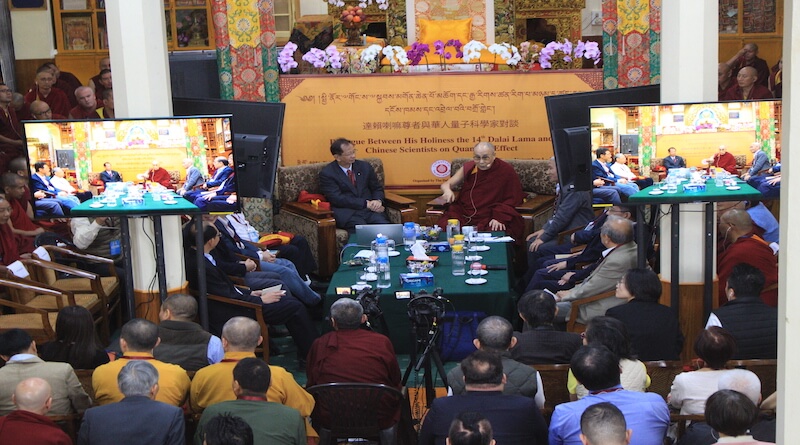Tibetan Buddhism cannot serve Chinese ambitions
After suppressing religion for 60 years, Beijing’s policy of using Buddhism to help foreign policy is doomed to failure
Sang Jieja | UCA News.com | Nov 9, 2018
In between the Sino-American trade war which has triggered a full-scale confrontation, the so-called One Belt, One Road initiative peddled by the Chinese Communist Party (CCP) is also attracting opposition in European countries.
Meanwhile, the Chinese government is calling on Tibetan Buddhism to gilt the One Belt, One Road project, which involves infrastructure development and investments in countries in Europe, Asia and Africa. Is it possible?
According to the website of the United Front Work Department (UFWD), the High-level Tibetan Buddhism College of China, along with the Tibetan Buddhism Colleges of Tibet, Sichuan, Yunnan, Gansu and Qinghai, jointly held a symposium in Qinghai on Oct. 16, partly on how Tibetan Buddhism can serve the initiative.
CCP officials were there in abundance, including Renqing Anjie, vice-president of the Buddhist Association of China and dean of the Qinghai Tibetan Buddhism College; Wang Changyu, secretary of the leading party members’ group of the High-level Tibetan Buddhism College of China; Zhang Liangtian, deputy minister of the UFWD of the Tibetan Autonomous Region and secretary of the party committee of Tibetan Buddhism College; Licai Renjia, associate dean of Gansu Buddhism College; and Luo Dela, full-time deputy director of the Tibetan Office of Qinghai Provincial Committee’s UFWD.
Some participants demanded that Tibetan Buddhism actively serve the development of One Belt, One Road, the party and the country, claiming that Tibetan Buddhism is China’s soft power and, if used properly, it could become a hard power.
The CCP has already implemented its policy of “actively guiding Tibetan Buddhism to adapt to a socialist society” and “a new interpretation of the doctrine of Tibetan Buddhism.”
But the problem is that the CCP’s suppression of Tibetan Buddhism and other religions has sullied its reputation in the world. Now it is calling on religions to serve the police as the aims of One Belt, One Road are frequently thwarted. How can it suppress Tibetan Buddhism on one hand but try to use the soft power of Tibetan Buddhism as a hard power to promote One Belt, One Road initiatives on the other hand?
This reveals that the CCP is desperate, and it is very funny. It also shows that its practice of the “Thick Black Theory” (ruthlessness and hypocrisy in seeking power) has already reached a point unmatched in history. The CCP would do anything unscrupulously for its own interests.
However, it is very simple for the CCP to suppress and control Tibetan Buddhism in Tibet but not so easy to use Tibetan Buddhism to serve its purposes abroad.
First, the CCP’s destruction of Tibetan Buddhism over the past 60 years has been obvious to all, and it is even worse now. Therefore, if you want to have suppression first and sell it abroad later, there is no market.
Secondly, during these six decades, exiled Tibetans have taken Tibetan Buddhism to the world, where it has rooted, sprouted and borne fruit. As the outside world is not completely strange to Tibetan Buddhism, the CCP wants to use its own Tibetan Buddhism to win the hearts of people. Could it be an easy job?
Moreover, when mentioning Tibetan Buddhism abroad, the first thing that comes into people’s minds is “Tibet” rather than “China.” Although the Chinese government always writes the word “China” specifically in front of “Tibetan Buddhism” and “Tibet” — and uses all the power of the state to carry out the Sinicization of Tibetan Buddhism — “Tibetan Buddhism” is still the official nomenclature used in all languages of the world. It is impossible for the CCP to change it.
Finally, the iconic figure of Tibetan Buddhism in the world is His Holiness the Dalai Lama, while the 17th Karmapa is recognized as the head of all leaders of the major sects of Tibetan Buddhism and their disciples all over the world. The CCP’s intention to open up a new environment for Tibetan Buddhism is a superfluous addition.
In the past, the CCP has tried to use Tibetan Buddhism to serve its political purposes internationally, but Tibetan Buddhism has been spreading across the Western world for nearly 60 years and its major sects have taken root.
In addition, the CCP does not trust any Tibetans. It is apparently allowing Tibetan Buddhists to go abroad to preach Buddhism, but it is worried that they will flee and rebel. As they are guarded and restricted everywhere, these Tibetan Buddhists find it hard to be effective.
In fact, the Buddhism politicized by the CCP cannot compare with traditional Buddhism. Tibetan Buddhism is part of the Tibetan civilization, not Chinese civilization. What makes the CCP gnash its teeth in anger is the Dalai Lama in exile. He and the leaders of all Tibet’s major sects are the real symbols of Tibetan Buddhism. Therefore, at the Qinghai symposium about developing Tibetan Buddhism to serve One Belt, One Road, some participants claimed that most resistance was coming from the Dalai Lama in India.
Many years ago, the CCP’s toadies in the Chinese religious and intellectual communities also advocated using Tibetan Buddhism as a platform to promote exchanges between China and foreign countries as part of government diplomacy.
These so-called scholars and religious figures flattered the CCP to gain recognition while concealing the truth, but they are really in trouble today if they want to use Tibetan Buddhism for One Belt, One Road. Such behaviour will make them the laughing stock of the world.
Sang Jieja is a Tibetan writer, commentator and a former Chinese spokesman for the exiled Tibetan government. He is now studying in Spain.
The views expressed in this article are that of the author’s and should not be attributed to Tibet Express.






